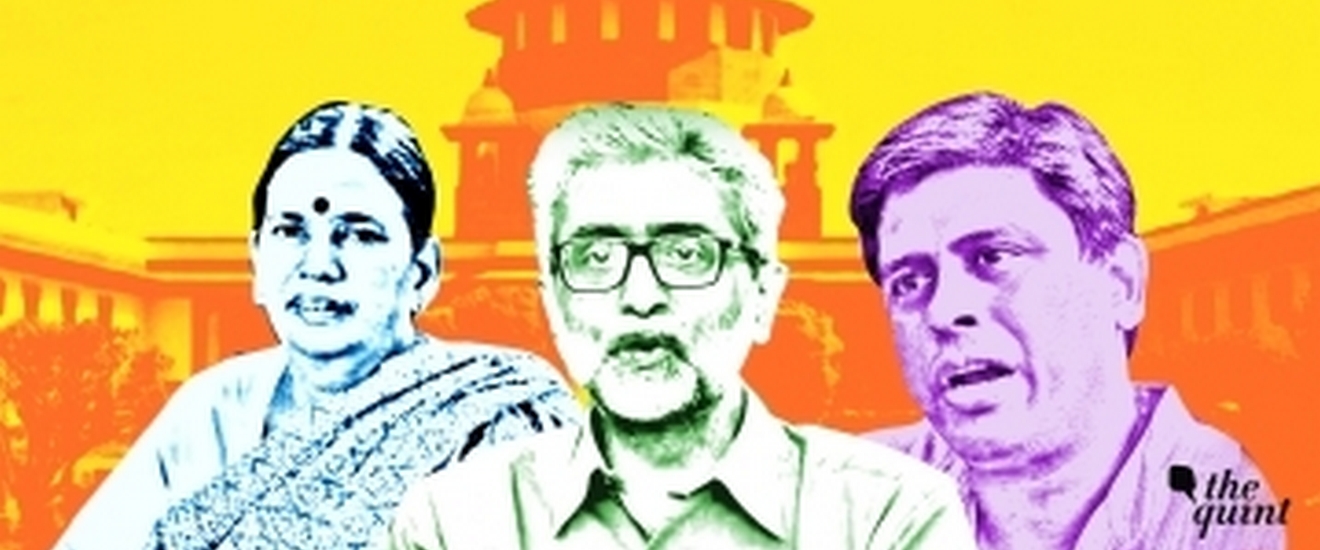Analysis
#4 Arrested Activists
Five human rights activists arrested in connection with the Bhima Koregaon violence under the UAPA Act.

Romila Thapar vs. Union of India
4.1 – Did the SC need to intervene to release the arrested activists?
4.1.1 – On August 28th, the Maharashtra Police carried out simultaneous raids across different parts of India, resulting in the arrests of five human rights activists: Sudha Bhardwaj, Gautam Navalakha, Varavara Rao, Vernon Gonzalves and Arun Farreira. The police claim the activists were responsible for the Elgaar Parishad in January 2018, which allegedly triggered the Bhima Koregaon violence.

Source: Press Trust India
4.1.2 – What is the Unlawful Activities Prevention Act?
The activists who were arrested were charged with Offences under the Unlawful Activities Prevent Act, 1967 (UAPA), a counter terror legislation. The provisions of the UAPA restrict the exercise of fundamental freedoms under Article 19 of the Constitution in order to protect the sovereignty and integrity of India. The Act defines unlawful activities in a broad manner, which includes activities aimed at disrupting the territorial integrity of India.
4.2 – Who were the Petitioners?

Source: The Quint, date accessed 23 Dec 2018
4.2.1 – It was not the arrested persons themselves, but 5 eminent citizens who submitted a joint petition to the Supreme Court challenging the arrests by the Maharashtra Police. The petitioners were Romila Thapar, Devaki Jain, Prabhat Patnaik, Satish Deshpande and Maja Dharuwala
4.2.2 – Prior to the August arrests, the Maharashtra Police had also arrested Shoma Sen, Surendra Gadling, Mahesh Raut, Rona Wilson and Sudhir Dhawale on 7th of June 2018. A second petition challenging these arrestees was subsequently tagged with this case.
4.3 – Should individuals be allowed to approach Supreme Court directly in criminal cases citing larger public interest?
A key argument before the court was that of locus, i.e. neither were the petitioners arrested themselves nor are they related to the arrested activists. Further, the five arrested activists were already seeking legal remedy by approaching the High Courts. The court allowed the petitions on the ground that they were connected to freedom of expression which allows for relaxed locus before the court.
4.4 – What did the Court decide?
4.4.1 – In the first hearing, the court changed the arrest order to one of house arrest (for the duration of the hearings). Given that the petitioners had sought for an independent investigation into the arrests made by the Maharashtra Police, the Court’s final ruling could have had three possible outcomes: do not interfere, constitute an independent Special Investigation Team (SIT), or quash the investigation and release the arrested activists.
4.4.2 – The Court rejected the plea for a SIT probe in a 2:1 majority judgment. The Court held that investigating authorities had successfully refuted the claim that the arrests suffered from a lack of evidence. Interestingly, the majority verdict did not go into the questions of the fundamental right violations alleged by the arrested persons and this aspect was only dealt with in the dissenting opinion by Chandrachud J who concluded that there was a need to constitute a SIT to conduct a Court monitored investigation as sufficient doubt had been cast on the impartiality of the Maharashtra Police.
4.4.3 – In the aftermath of the decision, significant public attention has been drawn to the strict and draconian provisions of the UAPA.
4.4.4 – The Supreme Court extended the house arrest by 4 weeks from the date of judgment, within which the arrested activists could move for bail in lower courts. In October, the Pune Trial Court rejected the bail plea of Bharadwaj, Gonsalves and Ferreira while the Hyderabad High Court extended the house arrest of Rao. Of the five activists, only Navlakha managed to get the transit custody of the Maharashtra Government quashed.
4.5 – 5 Must Reads
4.5.1 – Arshu John for The Caravan writes on whether the dissenting opinion authored by Justice Chandrachud was originally the unanimous verdict by the Bench.
4.5.2 – Abhinav Sekhri discusses the verdict in view of the larger issues involved in constituting SITs in cases of criminal investigation.
4.5.3 – Rajshree Chandra writes on the deployment of restrictive laws like the UAPA and its repercussions on the subversion of democratic freedoms.
4.5.4 – Ashutosh Bhardwaj criticizes the government for inventing the word “Urban Naxals” as it creates a mythical aura around a dying Naxal Movement.
4.5.5 – Kai Schultz and Suhasini Raj writes in The New York Times about the State onslaught on marginalized and resistance groups who speak out against the government.
